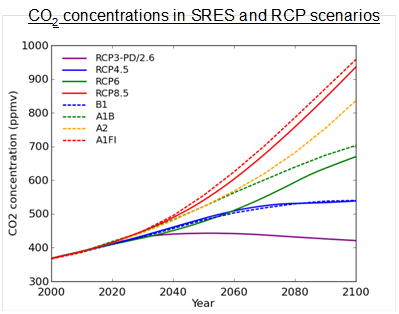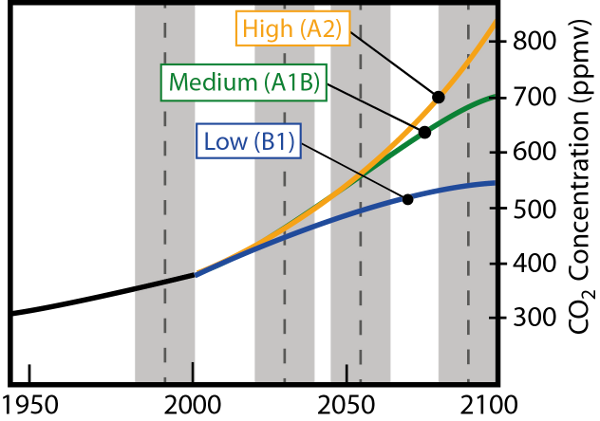Emissions Scenarios
The climate projections provided through Climate Futures are based on climate model simulations following a set of emissions scenarios that are consistent with certain socio-economic assumptions of how the future may evolve. For the latest set of climate models, as used in the IPCC’s Fifth Assessment Report (the CMIP5 set of models), the emissions scenarios are called Representative Concentration Pathways (RCPs). For the previous set of models, as used in the IPCC’s Fourth Assessment Report (the CMIP3 set of models), three of the scenarios described in the IPCC’s Special Report on Emissions Scenarios (SRES) were used.
Representative Concentration Pathways (RCPs)
Four RCPs have been defined and these are labelled according to the radiative forcing (W/m2) associated with that particular pathway by the end of the 21st century:
- RCP8.5 a high emission scenario
- RCP4.5 and 6.0 intermediate emission scenarios
- RCP2.6 low emission scenario.

Comparison of carbon dioxide (CO2) concentrations (ppm) for the old (SRES) scenarios B1, A1B, A2 and A1FI, and the new scenarios RCP2.6, RCP4.5, RCP6 and RCP8.5 (Collier et al., 2011). The A1FI SRES scenario is not available in Climate Futures
Source and further information: RCP Database
Time Periods
Changes are calculated from the 20 year base period 1981-2000 with eight future time periods available: 2030, 2040, 2050, 2055, 2060, 2070, 2080, and 2090.
Scenarios from the Special Report on Emissions Scenarios (SRES)
The Special Report described around 40 different scenarios of greenhouse gas emissions. For the CMIP3 experiments, most modelling groups used just three of these: B1, A1B and A2.
SRESB1
The B1 scenario describes a convergent world with the same low population growth as in the A1 storyline, but with rapid changes in economic structures toward a service and information economy, with reductions in material intensity, and the introduction of clean and resource-efficient technologies. The emphasis is on global solutions to economic, social, and environmental sustainability, including improved equity, but without additional climate initiatives.SRESA1B
The A1B scenario describes a future world of very rapid economic growth, low population growth, and the rapid introduction of new and more efficient technologies, with a balanced emphasis on all energy sources. Major underlying themes are convergence among regions, capacity building, and increased cultural and social interactions, with a substantial reduction in regional differences in per capita income.SRESA2
The A2 scenario describes a very heterogeneous world. The underlying theme is self-reliance and preservation of local identities. Fertility patterns across regions converge very slowly, which results in high population growth. Economic development is primarily regionally oriented and per capita economic growth and technological change are more fragmented and slower than in other storylines.
Figure: Emissions Scenarios, Low (B1) with CO2 concentrations of 540 ppm at 2100, Medium (A1B) with CO2 concentrations of 703 ppm at 2100 and High (A2) with CO2 concentrations of 836 ppm at 2100
For further information refer to IPCC Special Report on Emissions Scenarios
Time Periods
Changes are calculated from the 20 year base period 1981-2000 with three future time periods available: 2030, 2055 and 2090.
